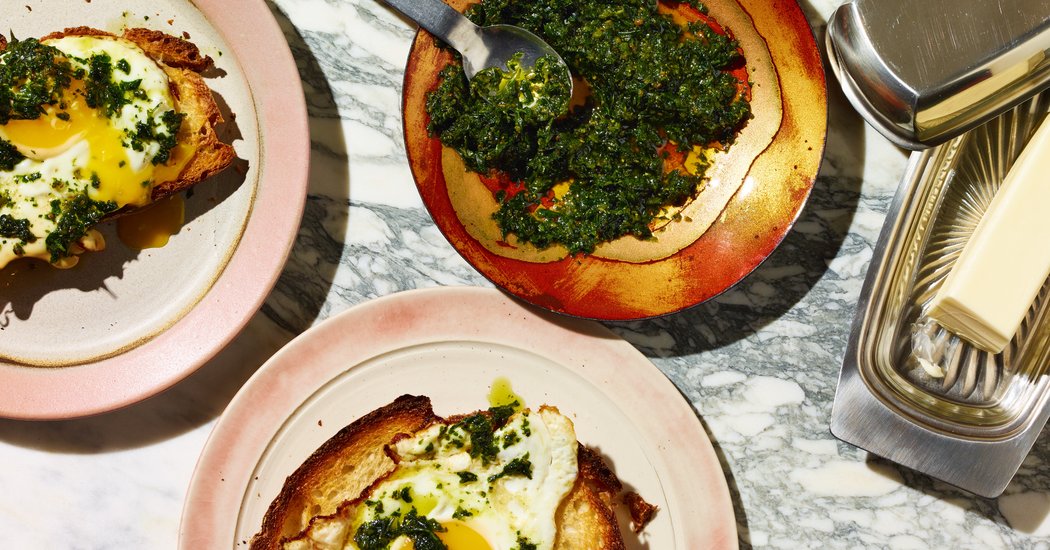
For the entirety of Prune’s 20 years, I’ve confined myself — with pretty strict discipline — to cooking within a European-and-Mediterranean idiom. It has been two decades of salsa verde, gremolata, sauce gribiche and maître d’hôtel butter, with all the rest doused in olive oil. Of course, giving yourself the entire European-and-Mediterranean pantry is hardly a confinement. Somehow it has never even proved to be a monotony. It has just been a nonnegotiable outline of territory on a map, so that we all know how far we can go and what we are meant to be doing as we cook menu after menu after menu, season after season, six new menus a year, 20 solid years in a row. And that’s not counting desserts.
But when I’m cooking at home, there have never been any equatorial or hemispheric confines — mapo tofu, larb salad, goma-ae, smorrebrod all in rotation, with free abandon. And recently, a heaping spoonful of zhug pretty much every day. With this bright green Yemeni sauce, spicy from serranos, perfumy from cilantro, I’m getting ready to expand the territory at work.
I’ve had both the green and the red versions at Yemen Cafe in Hamtramck, a suburb of Detroit that used to be heavily Polish but now has immense Yemeni and Bangladeshi populations. During a recent visit this summer, I stopped in to finally find out how to pronounce “zhug,” thoroughly annoyed by my own chronic stumbling over the “zh” as if it were the leg of a chair in my own den that I habitually stub a toe on. (Time to simply move the chair, G.H.!)
There were a few Yemeni teenagers working the counter who offered me some tea from an aluminum percolator like the one used for coffee at meetings in church basements — this tea overwhelming with clove and white sugar. I asked the guys at the cafe to repeat “zhug” for me over and over again to be sure I got it, because the sound was so wildly unlike the English transliteration. I’d been walking around using soft z and a hard g and was so incredulous at their insistent hard s and the hard k at the ending that finally one of the teenagers at the register wrote it down phonetically on an order pad: s-a-h-a-w-k. He pronounced the “haw” portion exactly like the hao in Mandarin ni hao, and very kindly put an extra-large container of the stuff in my takeout order. I sat outside in the privacy of my parked car for a few minutes practicing the pronunciation and taking little sips from the container he had packed.
I think they make their sauce in a food processor, and I would, too, if I were making such a large quantity. But the zhug we use now at the restaurant we make in smaller batches, by hand in the molcajete, and it is intensely flavorful and full bodied, like a true Genovese pesto. And it’s wildly fragrant.
That aroma! There are a few moments in my two decades at work that I will never forget as far as smell goes: One year the strawberries were so intensely perfect I could smell them from down in the prep room while the farmer was still coming down the hatch from the sidewalk with flats of them. And there was an out-of-this-world, stop-you-in-your-tracks scent of pine trees and Aegean breezes that, I swear, carried all the way into the dining room when we were making Mastika syrup for fondant in the basement. And now there is this sauce, zhug. As soon as my wife, Ashley, starts pounding the cilantro and the cardamom with the serranos in the prep room, even the folks in the office with the door closed answering the phones all day wander out to see what smells so unbelievably knockout.
And yet for all its formidable power, Ashley’s version at Prune has achieved a harmony among the cardamom, cilantro, garlic and serranos — a difficult-to-achieve union given the strong flavor of each ingredient. So fresh, so vibrant, but with no one flavor more potent than another — nuance and punch simultaneously.
I’ve stirred it into ripe tomatoes and cucumbers and red onion with Bulgarian white cheese, like a version of Greek salad or with mozzarella as a version of Caprese, even. I’ve whipped it into soft butter and slathered it over grilled lamb chops — holy smokes! I’ve fried eggs and slipped them, sunny side up, into a shallow bowl of zhug, like a kind of shakshuka. And I’ve spooned a healthy dose onto a few hard-boiled, then roughly chopped, eggs for lunch — both in the same day.
You could cut fat cubes of tofu and blanch them for a couple of minutes in salted boiling water; then, once they’re well drained, bury the tofu cubes in a deep pool of zhug, for a stunning version of saag paneer but without the saag. Or the paneer. No cheese, no ghee. Totally vegan.
If you need a minute to let it sink in that the chef at Prune just recommended — in The New York Times — something vegan to eat, I will understand. But that is how persuasive this sauce is. I’ll keep that tofu dish for home cooking, though. So that we will always recognize ourselves in our cooking at work, we will spoon the zhug over braised lamb necks this fall menu.
Recipe: Zhug




